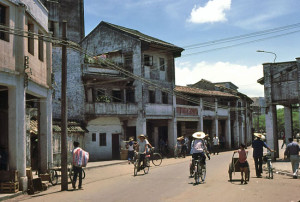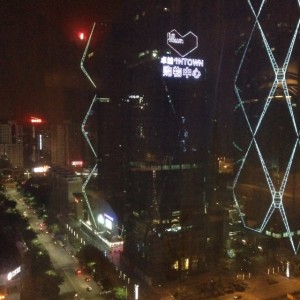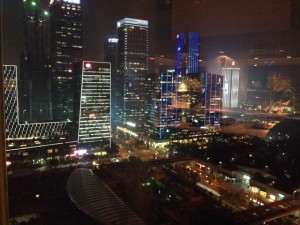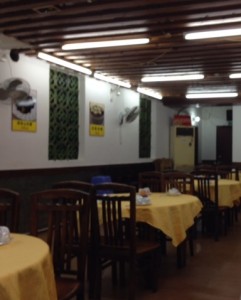
I’ve blogged previously about how interesting it is that WinHEC is returning, and the significance of its first appearance being in Shenzhen, China. Though I was invited to attend WinHEC this year, I opted not to go. I had been to Shenzhen before. And while the seafood is great and the shopping in next door Hong Kong is unsurpassed, it’s a long trip for from the US for what amounts to about a day a half of presentations (some of which are scheduled to be in Chinese) and a couple of nights of partying with friends.
Because most Windows software developers probably have not been to Shenzhen, I thought it would be interesting to start our series of blog posts about WinHEC 2015 with a post about the city of Shenzhen itself.

When I first traveled to China several years ago, I knew what to expect. Shenzhen is in Southern China, and right next door to Hong Kong. To my surprise, however, I found a lot of my friends and colleagues only had a vague idea of what China might be like. In talking to them, I found that many of them pictured old China, familiar from traditional paintings. To be sure, there are still old-style villages in some places in China. And Shenzhen was one such village as late as 1980, when it was named the first of China’s Special Economic Zones (SEZ). Naming Shenzhen an SEZ spurred unbelievably rapid development. Today, Shenzhen is considered by many to be China’s Technology Capital.
Shenzhen occupies more than 2,000 square kilometers (768 square miles) of land and has about 10 million residents (though, the population is difficult to determine… I’ve seen credible estimates as low as 8 million and as high as 14 million). The population of Shenzhen is therefore at least equal to that of New York City, and in terms of size it’s about 30% larger than Greater London. I call that a big city. But those figures don’t make Shenzhen a large city by Chinese standards. Beijing is more than 8 times larger in terms of land mass, and has twice as many people. Hmmm… I guess I’d call Beijing a really, really, big city.

By day, Shenzhen look a lot like any big, bustling, metropolis. Lots of cars, lots of taxis, lots of people, lots of skyscrapers. Busy people, doing busy things.
What made Shenzhen unique and interesting to me was how it lights up at night. Many of the buildings are illuminated with animated patterns to make them stand-out against the night sky.

So when you see the city at night, no matter which way you look, it’s like a fireworks display of light and color, with many of the lighting patterns dancing merrily. If you were expecting a traditional Chinese village, or even the huotong‘s of old Beijing, that’s definitely not what you’ll find in Shenzhen. “Everything you see here was built in the last 30 years,” my colleague in Shenzhen told me. “We consider a building that was built 30 years ago to be old. And many are torn down and replaced.”

What was as interesting as the city itself were the people I met there. Shenzhen has a special technology area known as the Shenzhen High-Tech Industrial Park (one of China’s five state-level high tech parks). The dedicated Software Park within the High Tech park has over 40K people working there. Most of the engineers that I met while in Shenzhen worked in the High-Tech park. There seems to be a significant concentration of folks working on tablets and phones, and Android was the most popular OS. One thing that was very noticeable was that all the engineers I met in Shenzhen were young. Before I arrived in Shenzhen, I didn’t realize that the average age of the residents there is less than 30! That makes Shenzhen a very dynamic and energetic engineering environment. The engineers I met were insightful, curious, and well… pretty much like software engineers you meet anywhere. The only difficulty was that, while their spoken English was far better than my spoken Chinese, they often had to work very hard to follow a technical discussion that was held entirely in English. This was why I was glad to read that several of the presentations for WinHEC Shenzhen were being scheduled in Chinese.
One of my favorite things to do when I travel is eat the local food. Shenzhen is located in Guangdong province, which was previously translated in English as “Canton”. Guangdong is, therefore, the home of the famous Cantonese cuisine. Guangdong dishes emphasize seafood (and Shenzhen is on the ocean), but almost every other protein you can think of (and, if you’re from the US, some you’d probably rather not think of) are abundantly on offer. The high quality of the local food, once you get out of the international hotels and away from “western” food, is evident even at small restaurants.

Like any rapidly developing area, Shenzhen is not without its problems. The main problem I heard from people who live there with was the cost of living. Though less expensive than cities such as Shanghai and Beijing, most things in Shenzhen are relatively expensive. This is particularly true of housing. In general, the cost of living is on-par with New York, Tel Aviv, or Copenhagen. And that is expensive by anyone’s measure.
So, that wraps-up my introduction to Shenzhen, China’s High Tech Capital. It’s a place I recommend that you visit if you get a chance. The food’s great, and the people are both smart and friendly. And, after hosting WinHEC, they’ll almost certainly be interested to talk with more Windows driver developers.
